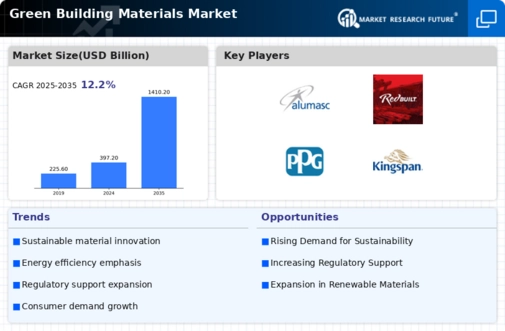Green Building Materials Market Summary
As per Market Research Future Analysis, the Global Green Building Materials Market was valued at USD 357.48 Billion in 2023 and is projected to reach USD 998.41 Billion by 2032, growing at a CAGR of 12.2% from 2024 to 2032. The market is driven by increasing consumer awareness of eco-friendly materials, government policies promoting energy-efficient buildings, and the rising demand for sustainable construction practices. The residential sector holds the largest market share, while roofing materials are expected to be the fastest-growing segment. The Asia Pacific region is anticipated to witness the highest growth rate, with significant contributions from India, Japan, and China.
Key Market Trends & Highlights
Key trends driving the Green Building Materials market include government initiatives, consumer awareness, and technological advancements.
- Government policies supporting energy-efficient buildings are crucial market drivers.
- The residential segment accounted for the majority share of the market revenue in 2021.
- The roofing segment is projected to be the fastest-growing segment during the forecast period.
- Asia Pacific is the fastest-growing region, with India, Japan, and China as key contributors.
Market Size & Forecast
| 2023 Market Size | USD 357.48 Billion |
| 2024 Market Size | USD 397.16 Billion |
| 2032 Market Size | USD 998.41 Billion |
| CAGR (2024-2032) | 12.2% |
Major Players
Major players include Alumasc Group plc, Bauder Ltd, Wienerberger AG, Binderholz GmbH, Homasote Company, CertainTeed Corporation, LG Hausys Ltd, RedBuilt LLC, PPG Industries, Inc., E. I. du Pont de Nemours and Company, Forbo International SA, Kingspan Limited, Lafarge Company, BASF SE.



 Source: Secondary Research, Primary Research, Market Research Future Database and Analyst Review
Source: Secondary Research, Primary Research, Market Research Future Database and Analyst Review











Leave a Comment